lets apply the scientific method to zelda (SS, BotW, TotK only)
Don't wanna be here? Send us removal request.
Note
Are you still doing the project or has it finished?
I hope so! Everything's kinda upside-down for me right now, but as soon as I get things figured out again, I look forward to continuing work on this project! Thanks for asking, it warms my heart to see people interested in my silly shenanigans. 💖
2 notes
·
View notes
Text
†Loftwing - Hyliava regius
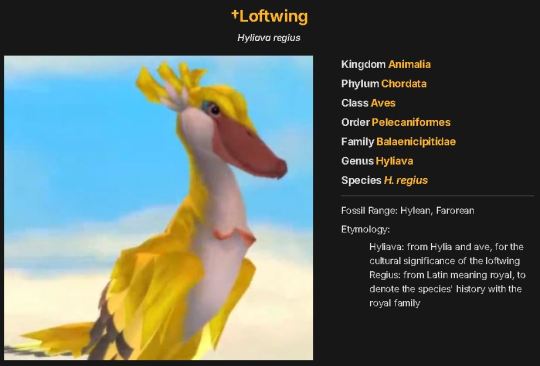
#have i done the loftwing yet? i don't think so#loz#lozss#skyward sword#lozanalysis#loztaxonomy#zelda#the hyrule encyclopedia says loftwings have some fur in areas instead of feathers#obviously not everywhere but now im curious if this is a thing in some real life birds or something they made up for loftwings
9 notes
·
View notes
Text
Moludga - Gerudae molduga molduga and Molduking - Gerudae molduga centusomnus


10 notes
·
View notes
Text
Water Buffalo - Bovinae orcbuccinus and Hateno Cow - Bos hatenus

B. orcbuccinus, indigenous to regions such as Akkala, the Lanayru Wetlands, and Nima Plain in southeastern Central Hyrule, constitute a wild bovine species. Their herbivorous diet includes safflina, various herbs, and aquatic grasses found along waterfronts.
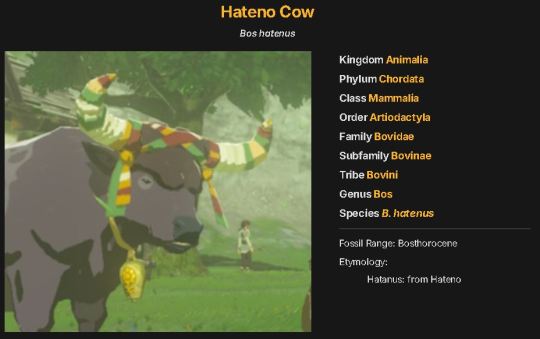
The wild water buffalo was selectively bred and domesticated into B. hatenus, the Hateno cow. Hateno cows are reared in populated locations such as Lurelin Village, Highland Stables, and Hateno Village. Hateno cows’ horns are often adorned with brightly colored linens, which may signify a cultural practice.
#loz analysis#loz taxonomy#botw#totk#the hateno cow enclosure in hateno village doesn't have fencing at the water line#probably because they can't swim#taxonomy#zelda
9 notes
·
View notes
Text
Blue Winged Heron - Ardea herodias caeruleus
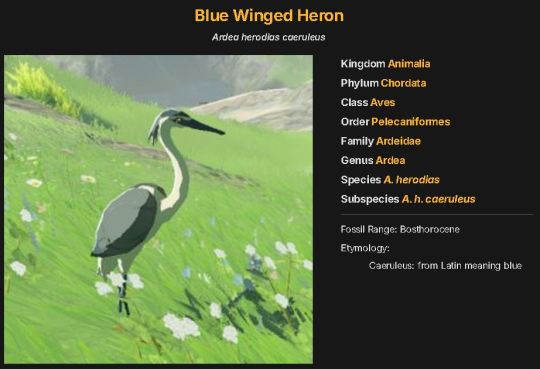
2 notes
·
View notes
Text
Cucco - Gallus domesticus cuccus
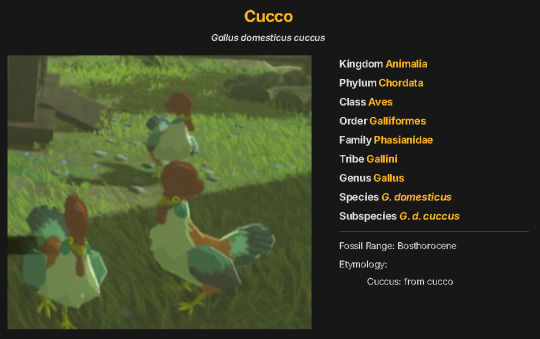
6 notes
·
View notes
Text
†Froak - Ruachia frokus
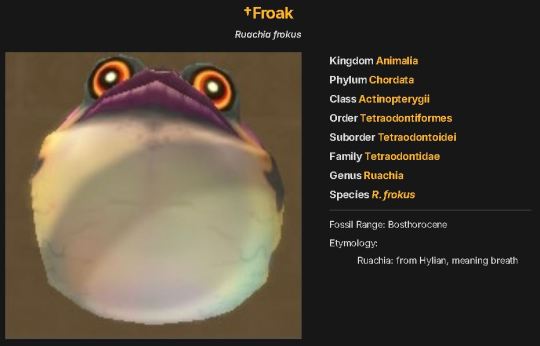
3 notes
·
View notes
Text
Armored Carp - Lanayae fortus

5 notes
·
View notes
Text
Genus Pacto - Pacto celeritepes, Pacto lentus, Pacto pluviaranae



#zelda#loz#loz analysis#zelda taxonomy#botw#totk#was sick for several days#don't know how long i was out#so here's three lil frog bois instead of one#they belong together anyway
14 notes
·
View notes
Text
Bladed Rhino Beetle - Debeckius forteferrus
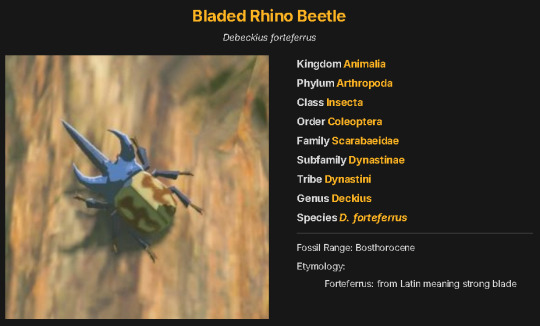
12 notes
·
View notes
Text
†Gerudo Leviathan - Alatus ventupiscus

A. ventupiscus exhibits bilateral symmetry in its spinal bone growth, indicating the presence of a secondary pair of appendages reminiscent of wings.
5 notes
·
View notes
Text
†Hebra Leviathan - Balaenoptera hebrus
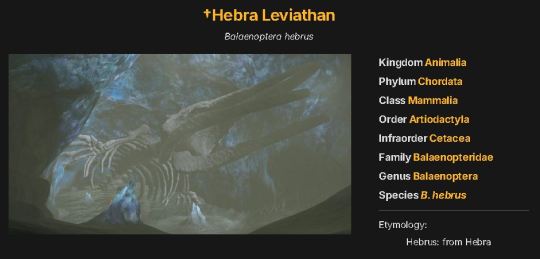
3 notes
·
View notes
Text
Wood Pigeon - Columba palumbus

2 notes
·
View notes
Text
Ancient Pigeon - Columba passumbus

Columba passumbus, a recently rediscovered species, represents the ancestral lineage of the contemporary wood pigeon. Remarkably, this species has endured in seclusion within the sky islands located above Hyrule, undergoing minimal or no discernible changes for tens of thousands of years..
19 notes
·
View notes
Text
†Camel - Camelus gorokatus

C. gorokatus is a theoretical species thought to have lived during the Passeroic and potentially the Gorozoic ages. This species has been postulated as a source of inspiration for the creation of wall art displayed at the Lightning Temple and for the conceptualization of Vah Nabooru's design.
5 notes
·
View notes
Text
Hylians and Gerudo (revisited)
In accordance with my previous post, here are the updated cards for ancestral hylians, contemporary hylians, and gerudo:

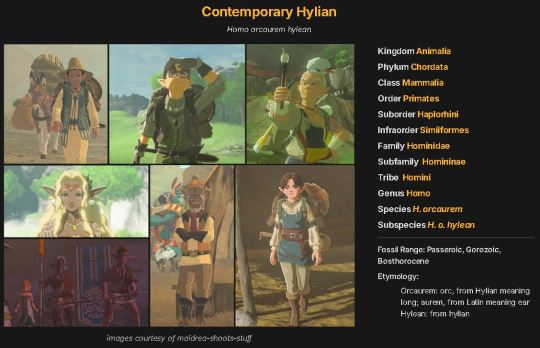

#can't believe I almost forgot to post these but here they are#zelda#legend of zelda#loz analysis#breath of the wild#skyward sword#tears of the kingdom
11 notes
·
View notes
Text
On the Evolution and Classification of Homo hylean and its Subspecies
For those who (understandably) don't want to read all this science mumbo-jumbo, this my conclusion (correcting an earlier post of mine that received valid constructive criticism):
Homo hylean - pointed eared humans: H. h. isean - ancestral hylians/Skyloftians and ancestral Sheikah H. h. hylean - modern hylians and Shiekah H. h. ehenxek - gerudo
Isean is derived from Voices of Hyrule's conlang. Ehenxek is derived from Nina-Kristine Johnson's conlang.
There is an argument made to consider all three subspecies of H. hylean as one singular species, also called H. hylean.
Below is a simplified representation of H. hylean's evolution.

Abstract:
This research focuses on the categorization of Homo hylean and its subspecies—H. h. isean, H. h. hylean, and H. h. ehenxek—providing a brief historical overview of the species. H. h. isean (colloquially called Skyloftians) is stated as the ancestor to all extant hylean subspecies. The paper highlights the inclusion of the Sheikah tribe and convential hylians as belonging to the same subspecies (H. h. hylean) and examines the distinctions between the hylian species and the Gerudo tribe. The ongoing debate revolves around whether to classify gerudo as part of the same species as hylians and Sheikah. The study concludes by noting the current classification of gerudo as a subspecies (H. h. ehenxek) that is distinct from hylians, but it raises the possibility of reclassifying all three hylean subspecies as belonging to the same species.
Body:
Homo sapien is a speculative species, with some genetic evidence, featured in the hylian legends that recount a conflict between the Twilight Realm and Hyrule, following the Interloper Conflict. They are regarded as the ancestors of all modern humans, owing to the mythology surrounding the origin of hylians' pointed ears. Rounded ears, deemed a retained ancestral (plesiomorphic) trait, serve as a primary distinguishing feature between H. sapien from H. hylean. While H. sapien appear in some accounts of hyrulean mythology, they are generally considered to be extinct by today's scholars. The last instance of rounded ears observed were of Ganondorf the gerudo during the Passeroic Age.
Homo hylean isean (ancestral hylians, often referred to as Skyloftians) first appeared in the Hylean Age, potentially as an offshoot of H. sapien. Their appearance marked the beginning of the Hylean. Hylians exhibit considerable genetic diversity, manifesting in a spectrum of traits such as diverse hair, eye, and skin colors, as well as a broad range of lifespans. The longest documented natural lifespan observed among contemporary hylians is approximately 126 years.
During the Farorean Age, historical records indicate that all humans (excepting Impa, the Servant of the Goddess) inhabited the sky islands. Given the current evidence showing only H. h. isean inhabited the sky during this period, it is reasonable to hypothesize H. sapien had gone extinct prior to the Farorean Age. At this time, H. h. isean had already demonstrated a diverse range of ethnic characteristics, likely inherited from the Hylean population and passed down over time. The confined geographical range of the hylians in the Farorean would have limited genetic diversification.
The Sheikah represent an ethnic tribe that belong to the same species as conventional hylians, being H. h. isean or H. h. hylean, depending on the geological age.
During the Passeroic Age, hylians exhibited elongated ears but retained a relative similarity to their Farorean ancestors. By the time of the Bosthorocene Age, there was a reduction in the length of hylian ears. The cause of this alteration is presently unknown.
Gerudo (H. o. ehenxek) and their Genetic Relationship with Conventional Hylians (H. o. hylean):
During or before the Passeroic Age we see a split in H. h. hylean, resulting in the emergence of H. h. ehenxek (gerudo) and H. h. hylean (hylians, including Caucasian hylians, Shiekah, and Lurelins, as well as others). It is probable that the gerudo were derived from non-Sheikah hylians, exhibiting numerous shared traits. Over successive periods, likely influenced by geographic isolation, the gerudo population underwent genetic divergence from their hylian progenitors, suggesting a potential process of subspeciation. Some divergences are as follow:
—Prevelance of the following variations in the MC1R gene: R151C (Arg151Cys), R160W (Arg160Trp), D294H (Asp294His), R142H (Arg142His), and I155T (Ile155Thr), resulting a red-colored hair.
—Enhanced growth hormone metabolism allowing for heights of up to or exceeding 2.4 meters (8 feet).
—Importance given to thermoregulation genes that help to adapt to significantly hot or cold environments, such as the conditions prevelent in the Gerudo Desert.
—Either of both (1. a sex chromosome change (having three or more X chromosomes) (2. a mutation in the SRY gene causing offspring to develop with almost exclusively female traits
Gerudo reproduce through gynogenesis. In gynogenesis, the typical scenario involves the exclusion of paternal genetic information; however, rare instances have been documented where a minimal amount of paternal genetic material is transmitted (such as the rounded ears of Ganondorf, as mentioned above, which may have been the result of a de novo mutation in his father's genes). This leads to the exclusive inheritance of gerudo traits, despite the presence of a hylian father. While there is no reputable record or observation, there exists the theoretical possibility that Gerudo may be capable of reproducing asexually, given that gynogenesis is a form of hybridogenesis, which necessitates asexual reproduction as a fundamental component.
Of the genetic differences listed, gynogenesis and the mutations involving the sex chromosomes and SRY genes were likely the last to evolve, as gynogenesis, in particular, does not necessarily facilitate genetic alterations across generations. These genetic distinctions have been evident since at least the Passeroic Age.
It is important to note that although gerudo posess many genetic differences from hylians, they still share numerous similarities, with the two groups likely sharing more than 99% DNA*. Gerudo and hylians are recognized as belonging to the same species, as they share reproductive compatibility, morphological and genetic similarities, behavoral traits, and an ability to share genetic material. However, the two are sometimes seperated into subspecies, owing to their reproductive isolation and general geographical differences.
The decision to categorize the gerudo and hylians as distinct subspecies has stirred controversy within various circles, prompting calls for a reevaluation of this classification. Advocates argue the reproductive compatibilty is reason enough to consider gerudo and hylian the same subspecies. However due to gynogenesis resulting in a near exclusivity of the inheritence of maternal genes, this claim is difficult to validate. If H. h. ehenxek and H. h. hylean were reclassified as belonging to the same subspecies, this would likely also include H. h. isean, reclassifying all three subspecies as one species, likely H. hylean.
Meta
The Handbook to Hyrule currently recognizes the accounts of Skyward Sword, Breath of the Wild, and Tears of the Kingdom as authoritative sources. Additional narratives are categorized as supplementary literature** and, essentially, are viewed as components of mythology, owing to their frequent conflicting narratives. While some insights may be derived from these supplemental sources, they are deemed ancillary and lack the necessary gravitas for serious scholarly credibility. However, this study integrates information gleaned from such speculative Hyrulean history and mythology.
*Gerudo are recognizably more similar to hylians than humans are to their closest living relative, chimpanzees. Since humans and chimpanzees share 98.8% DNA, it can be reasonably assumed that gerudo and hylians share more than this percent.
**Supplemental literature refers to titles outside of Skyward Sword, Breath of the Wild, and Tears of the Kingdom that are produced by or in association with Nintendo. This includes the main line of video games, a few games by third-party companies (such as Cadence of Hyrule and the Hyrule Wariors series), and the various manga (including Himekawa, Cagiva, and Mishouzaki), as well as others. These titles are treated as apothecary retellings of events that may have happened in Hyrule's history or may have been entirely fabricated. These titles are recognized as falling under Hyrule's mythology. Some credibility is lent to these titles, such as in cases of repeated similar accounts in different pieces of literature, or accounts supported by evidence found in authoritative sources. This decision was made after real-world years of deliberation and attempts to fit every title from the main series into one coherent canon. A decision was made to separate the titles by groups wherein the titles are integral to one another or are deeply connected. Handbook to Hyrule aims to focus on the group that includes SS, BotW, and TotK, owing to TotK being the most recent title released as of the official start of Handbook to Hyrule's online presence. Additional titles are included as Hyrulean mythology due to comments made by Nintendo in response to Breath of the Wild's timeline placement. These comments hint at all previous games being in-universe legends and mythology in the context of Breath of the Wild.
#okay i went into a WILD rabbit hole of genetics and types of reproduction that i did not expect to be reading about this morning#i hope this is all (at least mostly) accurate#but im not a scientist in any way so i may have gotten some things wrong#this is the first thing akin to a “scientific paper” i've ever done so this was kind of fun#but i need to get back to doing important things so it'll be relatively easy animal classifications for a bit from now on#zelda#legend of zelda#breath of the wild#skyward sword#tears of the kingdom
5 notes
·
View notes